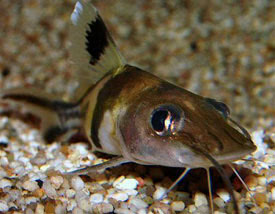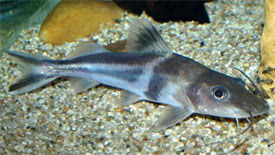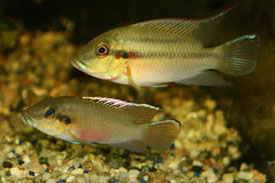
 Magyarul / Hungarian
Magyarul / Hungarian


- Scientific name: Pimelodus ornatus
- Synonyms: Megalonema rhabdostigma
- Common name: Ornate pimelodus, Ornate Pim
- Group: Catfishes
- Habitat: South America; Colombia, Venezuela, Guyana, Suriname, Ecuador, Peru, Brazil, Paraguay, Argentina
- Size: 24-28 cm
- Biotope: Inhabits in shallow, flowing rivers over sandy or muddy substrates. Also found in pools, small lakes and flooded areas.
- Social behavior: Quite peaceful catfish which can be kept alone, but will be more active in small groups. Predatory fish, they will eat smaller tank mates.
- Diet: Carnivorous; Frozen and live meaty foods such as bloodworm, chopped earthworm, tubifex and small fish. Flake foods are also accepted. Try not to overfeed them.
- Breeding: Not successful in aquarium.
- Tank: Minimum 350 litres
- Population: 3-4 fish for 500 litres
- Decoration: The species needs a lot of swimming room. Substrate should be fine sand. Use dim lighting and provide additional hiding places under stones or roots. In a brightly lit tank the fish won’t be active, except at feeding time.
- Temperature: 24-25 °C
- pH: 6-7.2
- Hardness: 2-18 NK°
- Lifespan: 20 years
Description: Pimelodus ornatus has three characteristic dark, broad bands on its body: the first runs from the base of the dorsal fin along the back to the upper lobe of the caudal fin, the second band runs below the first, separated by a thick white line, while the third wedge-shaped band runs down from the dorsal fin and ends between the pectoral and pelvic fins. The head is dark grey, and there is a black mark on the dorsal fin. The belly is white. Ornate Pim has very rigid pectoral and dorsal fin spines, which are secrete toxic mucus and the wounds caused by the spines can be very painful. With their maxillary barbles, that extending behind the ventral fins, and with the four smaller mandibular barbles they can locate all possible foods in the tank. Interestingly they can emit loud grumbling noises which deters the aggressor from their territory. Unfortunately very rarely imported catfish, and can be very expensive, as almost all of them are wild caught.
Sexual dimorphism is unknown, although adult female might has stockier body. In their natural habitat Ornate pimelodus is a migratory species, travelling large distances upstream during the wet season to spawn. The changes in the environment and water chemistry required to simulate migration would be almost impossible to reproduce in an aquarium. In nature the species breeds by internal fertilization and the female places the fertilized eggs on stones and plants.



































